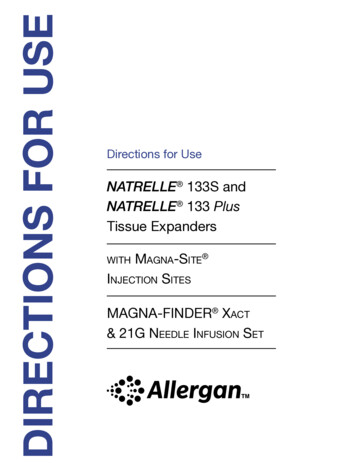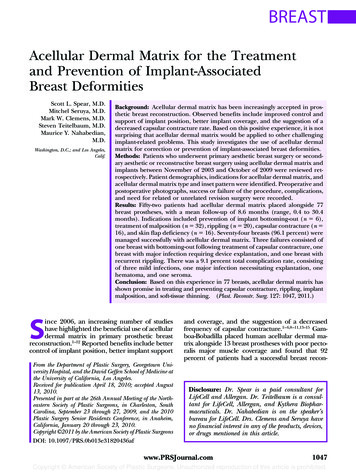
Transcription
DIRECTIONS FOR USEDirections for UseNATRELLE 133S andNATRELLE 133 PlusTissue ExpandersMagna-Site Injection SiteswithMAGNA-FINDER Xact& 21G Needle Infusion Set
CAUTION: U.S. Federal law restricts this device to sale by or on the order of a licensed physician.
TABLE OF CONTENTSSectionPageNATRELLE 133S Tissue Expanders.2 NATRELLE 133 Plus Tissue Expanders.4Description.6Tissue Expander Shapes.6Shell Characteristics.6Injection n That Should Be Provided to the PatientReactions.13Warnings, Precautions, Adverse ReactionsForm.13Informed Consent: Information for Patients FormEvents.13Possible Adverse EventsPossible AdverseBreast Implant Surgery PotentialAdverse Events.17EventsInstructions for Use.18Surgical Procedure.18Single Use.18Product Identification.19Sterile Product.19Product Accessories.19How to Open Product Package.19Preliminary Product Examination.20Techniques for Using Tissue Expanders.20Reporting and Return of Explanted Devices.25Returned Goods Policy.25Limited Warranty, Limitation of Liability and Disclaimer of Other Warranties.25Product Ordering.25Page 1
NATRELLE 133S TISSUE EXPANDERSNATRELLE 133S FVSTYLE 133 LVShaped Tissue Expander with6 Optional Suture TabsFull Height, Variable ProjectionSaline-FilledSmooth SurfaceMAGNA-SITE Injection SiteSTYLE 133 FXSTYLE 133 FVSTYLE 133 FXSTYLE 133 LVSTYLE 133 FXSTYLE 133 FVSTYLE 133 FXNATRELLE 133S MVSTYLE 133 MVShaped Tissue Expander with6 Optional Suture TabsModerate Height, Variable ProjectionSaline-FilledSmooth SurfaceMAGNA-SITE Injection SiteSTYLE 133 LVSTYLE 133 MVNATRELLE 133S SVSTYLE 133 MXShaped Tissue Expander with4 Optional Suture TabsShort Height, Variable ProjectionSaline-FilledSmooth SurfaceMAGNA-SITE Injection SiteSTYLE 133 FXSTYLE 133 MXSTYLE 133 SVSTYLE 133 MVSTYLE 133 SVSTYLE 133 SXPage 2STYLE 133 MVSTYLE 133 LVSTYLE 133 MVSTYLE 133 MXSTYLE 133 FXSTYLE 133 MXSTYLE 133 SVSTYLE 133 MVSTYLE 133 SVSTYLE 133 SX
STYLE 133 FXSTYLE 133 LVNATRELLE 133S FXShaped Tissue Expander with6 Optional Suture TabsFull Height, Extra ProjectionSaline-FilledSmooth SurfaceMAGNA-SITE Injection SiteSTYLE 133 FXSTYLE 133 LVSTYLE 133 FXSTYLE 133 FXSTYLE 133 MVSTYLE 133 MVSTYLE 133 FXSTYLE 133 MVSTYLE 133 FXSTYLE 133 MVNATRELLE 133S MXShaped Tissue Expander with6 Optional Suture TabsModerate Height, Extra ProjectionSaline-FilledSmooth SurfaceMAGNA-SITE Injection SiteSTYLE 133 MXSTYLE 133 MVNATRELLE 133S SXShaped Tissue Expander with6 Optional Suture TabsShort Height, Extra ProjectionSaline-FilledSmooth SurfaceMAGNA-SITE Injection SiteSTYLE 133 MVSTYLE 133 MXSTYLE 133 MXSTYLE 133 SVSTYLE 133 SVSTYLE 133 SVSTYLE 133 MXSTYLE 133 SXSTYLE 133 SVSTYLE 133 SXPage 3STYLE 133 MXSTYLE 133 SVSTYLE 133 MXSTYLE 133 SXSTYLE 133 SVSTYLE 133 SX
NATRELLE 133 PLUS TISSUE EXPANDERSNATRELLE 133 Plus FVSTYLE 133 LVShaped Tissue Expander withOptional Suture TabsFull Height, Variable ProjectionSaline-FilledBIOCELL TexturedMAGNA-SITE Injection SiteSTYLE 133 FXSTYLE 133 FVSTYLE 133 FXSTYLE 133 LVSTYLE 133 FXSTYLE 133 FVSTYLE 133 FXNATRELLE 133 Plus MVSTYLE 133 MVShaped Tissue Expander withOptional Suture TabsModerate Height, Variable ProjectionSaline-FilledBIOCELL TexturedMAGNA-SITE Injection SiteSTYLE 133 LVSTYLE 133 MVNATRELLE 133 Plus SVSTYLE 133 MXShaped Tissue Expander withOptional Suture TabsShort Height, Variable ProjectionSaline-FilledBIOCELL TexturedMAGNA-SITE Injection SiteSTYLE 133 FXSTYLE 133 MXSTYLE 133 SVNATRELLE 133 Plus LVSTYLE 133 FVShaped Tissue Expander withOptional Suture TabsLow Height, Variable ProjectionSaline-FilledBIOCELL TexturedMAGNA-SITE Injection SiteSTYLE 133 MVSTYLE 133 SVSTYLESTYLE133133LVSXPage 4STYLE 133 MVSTYLE 133 LVSTYLE 133 MVSTYLE 133 MXSTYLE 133 FXSTYLE 133 MXSTYLE 133 SVSTYLE 133 FVSTYLE 133 MVSTYLE 133 SVSTYLE 133 LVSX
STYLE 133 FXSTYLE 133 LVNATRELLE 133 Plus FXShaped Tissue Expander withOptional Suture TabsFull Height, Extra ProjectionSaline-FilledBIOCELL TexturedMAGNA-SITE Injection SiteSTYLE 133 FXSTYLE 133 LVSTYLE 133 FXSTYLE 133 FXSTYLE 133 MVSTYLE 133 MVSTYLE 133 FXSTYLE 133 MVSTYLE 133 FXSTYLE 133 MVNATRELLE 133 Plus MXShaped Tissue Expander withOptional Suture TabsModerate Height, Extra ProjectionSaline-FilledBIOCELL TexturedMAGNA-SITE Injection SiteSTYLE 133 MXSTYLE 133 MVNATRELLE 133 Plus SXShaped Tissue Expander withOptional Suture TabsShort Height, Extra ProjectionSaline-FilledBIOCELL TexturedMAGNA-SITE Injection SiteSTYLE 133 MVSTYLE 133 MXSTYLE 133 MXSTYLE 133 SVSTYLE 133 SVSTYLE 133 SVSTYLE 133 MXSTYLE 133 SXSTYLE 133 SVSTYLE 133 SXPage 5STYLE 133 MXSTYLE 133 SVSTYLE 133 MXSTYLE 133 SXSTYLE 133 SVSTYLE 133 SX
DESCRIPTIONNATRELLE 133S and NATRELLE 133 Plus Tissue Expanders are intendedfor temporary subcutaneous or submuscular implantation and require periodic,incremental inflation with sterile saline for injection until the desired amount oftissue is developed.NATRELLE 133S and NATRELLE 133 Plus Tissue Expanders are constructedfrom silicone elastomer and consist of an expansion envelope, an orientation line,and a MAGNA-SITE integrated injection site. The expanders are available in awide range of styles and sizes to meet diverse surgical needs.NATRELLE 133S Tissue Expanders are available with a smooth surfaceexpansion envelope and feature a clear orientation line and suture tabs thatcontain the colorant cobalt aluminate blue spinel at a concentration of 1%.NATRELLE 133 Plus Tissue Expanders have a BIOCELL texturedsurface and are available both with and without suture tabs. The orientationline and suture tabs contain the colorant cobalt aluminate blue spinel atconcentrations of 0.1% and 1%, respectively.All NATRELLE 133S and NATRELLE 133 Plus Tissue Expanders withthe MAGNA-SITE integrated injection port are supplied with a sterileMAGNA-FINDER Xact external locating device and a 21G Needle Infusion Set. Inaddition, Tissue Expander Fill Kits, Delivery Assistance Sleeves, and other productaccessories are available separately.For more information on specific styles and accessories, please contact yourHospital or Surgical Sales Representative, or the Customer Care Department at1.800.766.0171.Tissue Expander ShapesNATRELLE 133S and NATRELLE 133 Plus Tissue Expanders are designedas part of a system for breast reconstruction to create a pocket for placementof a NATRELLE breast implant.Shell CharacteristicsThe BIOCELL textured surface is designed to promote mild tissue adherenceand tissue expander immobility.Stable bases for greater control over expansion direction are included on allNATRELLE 133S and NATRELLE 133 Plus Tissue Expanders.Page 6
An orientation line is located on the lower pole of the device to aid in properlyorienting the device intraoperatively.Optional suture tabs can be utilized to anchor the device to pocket tissue,allowing for more secure placement.Injection SitesThe MAGNA-SITE injection site and MAGNA-FINDER Xact external locatingdevice contain rare-earth, permanent magnets for an accurate injection system.When the MAGNA-FINDER Xact external locating device is passed over thesurface of the tissue being expanded as described in INSTRUCTIONS FORUSE, its rare-earth, permanent magnet indicates the location of the MAGNASITE injection site.All injection sites contain a self-sealing port and a titanium needle guard (seeFigure 1) to prevent inadvertent puncture through the base of the injection site. Xact external locating deviceFIGURE 1:MAGNA-SITE & MAGNA-FINDER Xact Locating SystemNOTE: In vitro tests show that the MAGNA-SITE injection site isdetectable through 60 mm of phantom tissue.CAUTION: DO NOT use NATRELLE 133S or NATRELLE 133 Plus TissueExpanders in patients who already have implanted devices that wouldbe affected by a magnetic field (e.g., pacemakers, drug infusiondevices, artificial sensing devices).DO NOT perform diagnostic testing with Magnetic Resonance Imaging(MRI) in patients with NATRELLE 133S or NATRELLE 133 PlusTissue Expanders in place.See Magnetic Field under WARNINGS for more information.Page 7
The indications and contraindications in the sections that follow are generalized.Each patient must be individually evaluated for tissue expansion based on themedical judgment of a qualified surgeon.INDICATIONSNATRELLE 133S and NATRELLE 133 Plus Tissue Expanders can be utilizedfor breast reconstruction after mastectomy, correction of an underdevelopedbreast, scar revision and tissue defect procedures. The expander is intended fortemporary subcutaneous or submuscular implantation and is not intended for usebeyond six months.CONTRAINDICATIONSNATRELLE 133S and NATRELLE 133 Plus Tissue Expanders SHOULD NOTbe used in: Patients who already have implanted devices that would be affected by amagnetic field (e.g., pacemakers, drug infusion devices, artificial sensingdevices). Patients whose tissue at the intended expansion site is determined asunsuitable by the surgeon. To a varying degree, radiation damage, ulceration,compromised vascularity, history of compromised wound healing, or scardeformity may affect tissue suitability. Patients who have an active infection at the expansion site. Patients who have a residual gross tumor at the intended expansion sitethat may significantly complicate the expansion process and local tumortreatment. Patients undergoing adjuvant radiation therapy, which is a relativecontraindication and may make use of the tissue expander more difficult andincrease the risk of complications. Patients whose physiological condition is determined by the surgeon to poseunduly high risk of surgical and/or postoperative complications. To a varyingdegree, sensitive over or underlying anatomy, obesity, smoking, diabetes,autoimmune disease, hypertension, chronic lung or severe cardiovasculardisease, or osteogenesis imperfecta may affect patient suitability for tissueexpander surgery.Page 8
Patients whose use of drugs might result in high surgical risk and/or significantpostoperative complications, including any drug that would interfere withblood clotting or affect tissue viability. Psychologically unsuitable patients.WARNINGS1. Magnetic FieldDO NOT use NATRELLE 133S or NATRELLE 133 Plus Tissue Expandersin patients who already have implanted devices that would be affected bya magnetic field (e.g., pacemakers, drug infusion devices, artificial sensingdevices), because the MAGNA-SITE integrated injection site contains astrong rare-earth, permanent magnet.Diagnostic testing with Magnetic Resonance Imaging (MRI) is contraindicatedin patients with NATRELLE 133S or NATRELLE 133 Plus Tissue Expandersin place. The MRI equipment could cause movement of the tissue expander,and result in not only patient discomfort, but also expander displacement,requiring revision surgery. In addition, the MAGNA-SITE magnet couldinterfere with MRI detection capabilities.Allergan has not tested the in vivo effects of radiation therapy with NATRELLE 133S or NATRELLE 133 Plus Tissue Expanders and cannot warrant thesafety of such use. The decision regarding the use of NATRELLE 133Sor NATRELLE 133 Plus Tissue Expanders in patients about to undergoradiation therapy should be made by the surgeon and the radiation oncologist.See also Contraindications.2. AlterationDO NOT alter the tissue expander. Alteration to the original design andfabrication voids all warranties, express or implied.3. Adulterated FillDO NOT use adulterated fill. Expanders are to be filled only with sterile salinefor injection, and only as described in INSTRUCTIONS FOR USE. Allergancan neither predict, nor warrant, the safety of intraluminal introduction of anyadulterated fill, including, but not limited to, anesthetic, steroid, and antibioticsolutions.Page 9
4. ReuseDO NOT reuse explanted products. NATRELLE 133S and NATRELLE 133Plus Tissue Expanders are intended for single use only.5. Tissue DamageDO NOT expand if the pressure will compromise wound healing. DO NOTexpand beyond patient or tissue tolerance.Excessively rapid tissue expansion may compromise the vasculature of theoverlying tissue. Stop filling immediately if any signs of tissue damage, wounddehiscence, abnormal skin pallor (e.g., blanching), erythema, edema, pain,or tenderness are observed. In the absence of other signs, some temporaryerythema may occur as a recognized normal tissue response to expansion.Tissue viability may be adversely affected by radiotherapy, steroid use in thesurgical pocket, excessive heat or cold therapy, and smoking.See also Contraindications for initial patient exclusion criteria.6. InfectionActive infection anywhere in the body may increase risk of periprostheticinfection. DO NOT expose the tissue expander or injection needles tocontaminants, which increase the risk of infection. Patients who presentwound dehiscence, tissue erosion, ischemia or necrosis run an increasedrisk of periprosthetic infection. Measures to protect such areas from infectionshould be taken.Signs of acute infection reported in association with tissue expanders include,tenderness, fluid accumulation, pain and fever. Infection may compromise theexpansion process. Postoperative infections should be treated aggressivelyaccording to standard medical practices to avoid more serious complications.Infection that is unresponsive to treatment or necrotizing infection may requirepremature tissue expander removal.See also Infection, under ADVERSE REACTIONS.7. Temporary DeviceNATRELLE 133S and NATRELLE 133 Plus Tissue Expanders aretemporary devices, and are not to be used for permanent implantation orbeyond 6 months. Tissue expanders should be removed once adequatePage 10
tissue has developed. Tissue expansion in breast reconstruction typicallyrequires four to six months. The total expansion period will vary dependingon patient tolerance, tissue tolerance, and desired tissue expansion.8. Premature ExplantationAdverse reactions may require premature explantation.9. SuturingWhen using expanders with suture tabs, be careful to avoid piercing the shellwhen suturing the tabs. Discard the device and use a new one if damageoccurs.PRECAUTIONS1. Pre-existing InfectionPatients who present with any active infection may need to be treated and theinfection resolved before placement of the tissue expander.See also Infection, under WARNINGS and ADVERSE REACTIONS.2. Surgical PlanningAllergan relies on the surgeon to know and follow proper surgical proceduresspecific to the type of expansion performed to minimize the occurrence ofadverse reactions. The surgeon must carefully evaluate patient suitability forexpansion and desired physical outcome, tissue expander surface, tissueexpander dimensions, incision placement, pocket dissection, use of optionalsuture tabs, expander filling, and any other relevant dimensions, using current,accepted techniques and individual experience. Templates are availablethrough Allergan to assist the surgeon with tissue expander selection.3. Avoiding Contamination at SurgeryTo avoid contamination, aseptic technique is essential. DO NOT exposethe tissue expander to lint, talc, sponge, towel, and other contaminants.Contamination at the time of surgery increases the risk of periprostheticinfection, which could require premature explantation of the tissue expander.To minimize the risk of contamination, follow recommended proceduresin INSTRUCTIONS FOR USE.Page 11
4. Avoiding Damage During SurgeryExtreme care should be taken to avoid damage to the tissue expander duringsurgery. Possible sources of damage include sharp surgical instruments suchas scalpels and needles used during the initial surgery, subsequent filling, orhematoma/fluid evacuation.A sterile back-up tissue expander must be readily available at the time ofsurgery in the event that damage occurs. Products must be carefullyinspected for leaks or nicks prior to use. DO NOT attempt to repair damagedproducts.To minimize the risk of damage, follow recommended procedures inINSTRUCTIONS FOR USE for breast tissue expander handling,examination, placement, and filling.5. Maintaining Hemostasis/Avoiding Fluid AccumulationPostoperative hematoma and seroma may be minimized by meticulousattention to hemostasis during surgery, and possibly by postoperative use ofclosed drains. Persistent, excessive bleeding must be controlled before thetissue expander is placed. If the wound is stable the tissue expander may befilled to tissue tolerance at the time of surgery to help minimize serous fluidaccumulation in the surrounding pocket. If wound stability is a concern, inflateonly slightly to fill the pocket space, without applying tension to the tissue.Any postoperative evacuation of hematoma or other fluid accumulation mustbe conducted with care to avoid introduction of contaminants or damage tothe tissue expander from needles or other sharp instruments.6. Avoiding Tissue Damage During ExpansionAvoiding tissue damage during expansion requires careful attention to tissuetolerance, including: If the wound is stable, the tissue expander may be filled to tissue toleranceat the time of surgery; Expansion should proceed in moderate increments, never beyond patientor tissue tolerance; If tissue damage, abnormal skin pallor (e.g., blanching), erythema, edema,pain, or tenderness are observed, filling should immediately stop until theproblem is resolved.See also Tissue Damage under WARNINGS and ADVERSE REACTIONS.Page 12
7. Avoiding Tissue Expander Damage During ExpansionExtreme care should be taken to avoid needle puncture or other damage tothe tissue expander or the injection site during the expansion process.To minimize the risk of tissue expander damage during expansion, fill theexpander only with sterile saline for injection and use the appropriate locationmethods and instruments, as described in INSTRUCTIONS FOR USE.INFORMATION THAT SHOULD BE PROVIDED TO THE PATIENTWhile tissue expansion may be a beneficial surgical alternative for many patients,it may not be appropriate for every patient, because it is a time and labor-intensiveprocess that may cause temporary discomfort and distortion. The surgeon isresponsible for selecting appropriate candidates, and counseling those patientson the risk/benefit relationship. Before tissue expander placement, patients shouldfully understand the elective nature of the procedure, and be willing to comply withexpansion process requirements to minimize the risk of complications.Warnings, Precautions, Possible Adverse EventsAllergan relies on the surgeon to advise the patient of all warnings, precautions,and possible adverse events before the decision to proceed with tissueexpander placement and inflation. The surgeon should advise the patient thatadverse reactions may interfere with the original surgical plan and that medicalmanagement may include premature explantation.Informed Consent: Information for Patients FormNATRELLE 133S and NATRELLE 133 Plus Tissue Expanders InformedConsent: Information for Patients form may be used to facilitate patientawareness and acceptance of the risks associated with tissue expander surgery.The two-part form allows both the patient and the surgeon to retain copies fortheir records. Please contact your Hospital or Surgical Sales Representative orvisit www.allerganlabeling.com for informed consent forms.POSSIBLE ADVERSE EVENTS1. DeflationPatients should be advised that the tissue expanders may deflate, and requirereplacement surgery. Deflation occurs when saline leaks through a damagedinjection site or a damaged tissue expander envelope.See also Avoiding Damage During Surgery and Avoiding TissueExpander Damage During Expansion, under PRECAUTIONS.Page 13
2. Tissue DamageImproper patient selection, tissue expander selection, placement and inflationmay result in tissue damage and require premature explantation of thetissue expander. Signs of tissue damage include abnormal skin pallor (e.g.,blanching), erythema, edema, pain, or tenderness, and should be promptlyinvestigated. In the absence of other signs, some temporary erythema mayoccur, and is a recognized normal tissue response to expansion.The stresses of the expanding device may induce pressure ischemia andnecrosis, especially in tight or thin-skinned areas. Folds in a partially filledtissue expander may also result in thinning and erosion of adjacent tissue.Excessively rapid tissue expansion may compromise the vascularity of theoverlying tissue.Tissue viability may be adversely affected by radiotherapy, steroid use orother drug therapy in the surgical pocket, excessive heat or cold therapy,and smoking.See also Avoiding Tissue Damage During Expansion, under PRECAUTIONS.3. InfectionPre-existing infections not resolved before tissue expander placement mayincrease the risk of periprosthetic infection.Infection is an inherent risk following any type of invasive surgery, and mayoccur during the tissue expansion process. Patients who present with wounddehiscence, tissue erosion, ischemia or necrosis, and patients undergoingimmediate breast reconstruction run an increased risk of periprostheticinfection. Signs of acute infection reported in association with tissue expandersinclude erythema, tenderness, fluid accumulation, pain and fever.Erythema may also occur as a normal response to expansion. Aspiration todifferentiate between this type of erythema and erythema as a sign of earlyinfection is a recognized precaution.Research identifies Staphylococcus and Pseudomonas organisms inassociation with infection around tissue expanders. Escherichia andStreptococcus organisms have also been noted in association withtissue expanders in the lower extremities. Infection may occur at any timeafter surgery, and may compromise the expansion process. Capsularcontracture may be related to infection in the area surrounding the implant.Page 14
Postoperative infections should be treated aggressively according tostandard medical practices to avoid more serious complications. Infectionthat is unresponsive to treatment or necrotizing infection may requirepremature tissue expander removal.In rare instances, acute infection may occur in a breast with implants. Thesigns of acute infection include erythema, tenderness, fluid accumulation,pain, and fever. Very rarely, Toxic Shock Syndrome, a potentially lifethreatening condition, has been reported in women after breast implantsurgery. It is characterized by symptoms that occur suddenly and includehigh fever (102 F, 38.8 C or higher), vomiting, diarrhea, a sunburn-like rash,red eyes, dizziness, lightheadedness, muscle aches, and drops in bloodpressure, which may cause fainting. Patients should be advised to contact aphysician immediately for diagnosis and treatment for any of these symptoms.See also Infections under WARNINGS.4. ExtrusionTissue damage may compromise tissue covering and/or wound healing,result in extrusion, and require premature tissue expander removal.See also Tissue Damage, under WARNINGS.5. Hematoma/SeromaPostoperative hematoma and seroma may contribute to infection.Postoperative hematoma and seroma may be minimized by meticulousattention to hemostasis during surgery, and possibly by postoperative use ofclosed drains. Persistent, excessive bleeding must be controlled before thedevice is implanted.6. Capsular ContractureFormation of a fibrous tissue capsule around an implanted device is a normalphysiological response, although not all capsules contract. Contracture of thefibrous capsular tissue surrounding the tissue expander may cause a range ofsymptoms including firmness, discomfort, pain, distortion, palpability, and/ordisplacement. Contracture may make expansion difficult and painful.7. Premature ExplantationAdverse reactions may require premature explantation, which may affectdesired flap size.Page 15
8. DisplacementThe tissue expander may become displaced, especially if the surgical pocketis too large. Tissue expander displacement may make the integrated valvelocation difficult or impossible without surgical correction.9. Effects on BoneChest wall compression has been reported in association with the use oftissue expanders for breast reconstruction. The presence of a thick capsule,causing greater resistance to expansion, may be a contributing factor. Themedical literature indicates that following tissue expander removal, effectson bone caused by the pressure of expansion are often completely reversed.10. PainAs expected following any invasive surgical procedure, pain of varyingintensity and duration may occur following tissue expander placement. Inaddition, the expansion process may cause some discomfort, but should notcause excessive pain. Pain may indicate expansion beyond tissue tolerance,which could result in ischemia and necrosis. Pain may also accompany otheradverse reactions. Unexplained pain must be promptly investigated. Furtherexpansion should be discontinued until the pain is resolved.11. SensationThe possibility of temporary or permanent dysesthesia (abnormal sensation)exists following any invasive surgical procedure. Surgical technique andexpansion must be performed carefully to avoid neurological impairment.Nerve traction and compression have been reported in rare cases inassociation with tissue expansion. Immediate partial deflation should be astandard precaution if nerve impingement is suspected, and filling should notresume until the problem is resolved.12. DistortionTissue expansion is a time and labor intensive process that may causetemporary discomfort and distortion. Patients should be psychologicallysuitable, well-informed, and motivated to complete the expansion process.Patient response to the distortion of body image may vary. Negative reactionsmay include depression and withdrawal.Page 16
13. Inadequate Tissue FlapInadequate tissue flap following expansion may occur and may requireadditional surgery and expansion. In cases with limited viable donor sitetissue, such sequential expansion may be included as part of the originalsurgical plan.See also Surgical Planning, under PRECAUTIONS.14. Inflammatory ReactionStudies evaluating the capsules around textured expanders have reportedwhat were possibly silicone particles within giant cells, indicative of a local(and non-specific) foreign body reaction, and silicone granuloma formation.Another study suggests that certain types of capsule cells, including someperceived as giant cells, may actually be secretory cells that form in responseto the frictional forces of the tissue expander, providing lubrication at thecapsule-expander interface.BREAST IMPLANT SURGERY POSSIBLE ADVERSE EVENTSResearch continues to address the various hypothetical long-term effects ofsilicone implants, primarily silicone-filled breast implants. To the extent that suchresearch applies to the safety of silicone in general for implantation, it is relevant totissue expanders. However, given the intended temporary use of tissue expanders,and the fact that tissue expanders consist primarily of a silicone elastomer shellfilled with sterile saline for injection, the research has not been directly concernedwith tissue expander use.The following is a list of potential adverse events that may occur with breast implantsurgery. The risks include: implant deflation/leakage, additional surgery, capsularcontracture, infection, Toxic Shock Syndrome, necrosis, hematoma, seroma,extrusion, breast pain, changes in nipple sensation, changes in breast sensation,dissatisfaction with cosmetic results (wrinkling, folding, displacement, asymmetry,palpability, visibility, ptosis, sloshing), calcific deposits, irritation/inflammation,delayed woun
NATRELLE 133S and NATRELLE 133 Plus Tissue Expanders can be utilized for breast reconstruction after mastectomy, correction of an underdeveloped breast, scar revision and tissue defect procedures. The expander is intended for temporary subcutaneous or submuscular implantation and is not intended for use beyond six months. CONTRAINDICATIONS











